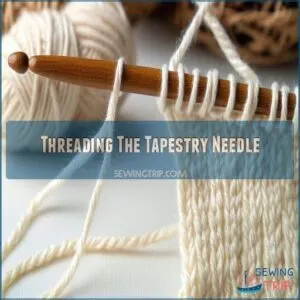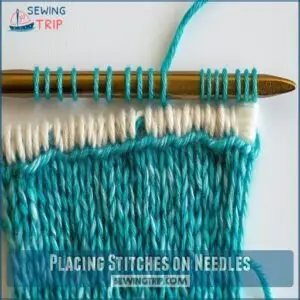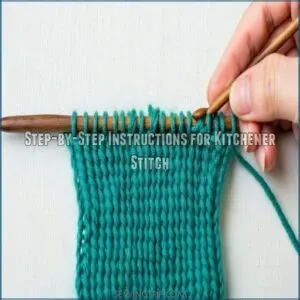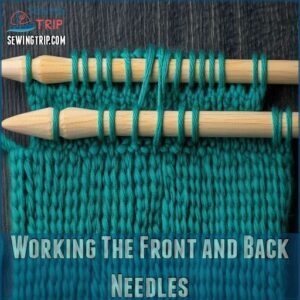This site is supported by our readers. We may earn a commission, at no cost to you, if you purchase through links.
 You’re about to discover the Kitchener stitch, a grafting technique that turns two separate pieces of knitting into one seamless masterpiece.
You’re about to discover the Kitchener stitch, a grafting technique that turns two separate pieces of knitting into one seamless masterpiece.
Named after a WWI British military leader, this method creates invisible joins that’ll make your socks, sweaters, and other projects look professionally finished.
You’ll need a tapestry needle and live stitches on two needles to work this magic.
Think of it as creating a smooth bridge between two knitted shores – no bumpy seams in sight!
Once you’ve mastered the basic knitwise and purlwise movements, you’ll open up endless possibilities for creating stunning, seamless designs.
Table Of Contents
- Key Takeaways
- Kitchener Stitch Definition
- Getting Started With Kitchener Stitch
- Kitchener Stitch Setup and Preparation
- Mastering The Kitchener Stitch Pattern
- Tips for Success and Common Mistakes
- Kitchener Stitch Variations and Applications
- Finishing The Kitchener Stitch Seam
- Advanced Kitchener Stitch Techniques
- Frequently Asked Questions (FAQs)
- Conclusion
Key Takeaways
- You’ll use the Kitchener stitch to create invisible seams between two pieces of knitting, making them look like one continuous piece—especially useful for sock toes and sweater seams.
- You’ll need three basic supplies: a tapestry needle, matching yarn from your project, and your knitting needles with live stitches evenly distributed.
- You can master the technique by following a four-step pattern: knit off the front needle, purl and leave on the front needle, purl off the back needle, and knit and leave on the back needle.
- You’ll achieve the best results by maintaining even tension throughout the process and checking your stitch count before starting to prevent common issues like puckering or bulging.
Kitchener Stitch Definition
Kitchener stitch? Don’t be intimidated – this clever joining technique is your key to seamless knitting success.
Kitchener stitch is your key to seamless knitting success.
Master the simple steps, and you’ll be closing up those socks and sweaters in no time!
Basic Technique and Use
Think of the Kitchener stitch as knitting’s secret handshake.
It’s a clever grafting technique that fuses live stitches for a seamless join.
You’ll typically use it for sock toe closures or garment finishing.
Just slip those stitches onto parallel needles, grab your yarn, and let the knitting techniques flow like magic.
Remember, practice makes perfect!
Importance of Seamless Join
You’ve mastered the basics, now let’s chat seamless joins.
Ever notice how a good stitch can make or break your sock construction or even affect garment appearance?
For those seeking supplies, try checking out Kitchener Stitch Knitting Tools.
That’s where the Kitchener Stitch shines.
By providing a seamless join, it creates a smoother texture in your knitting projects.
This technique is your go-to for a professional finish, perfect for stockinette stitch.
Origin of The Kitchener Stitch
The Kitchener stitch‘s roots can be traced back to Horatio Herbert Kitchener, a British military leader and avid knitter.
During World War I, Kitchener popularized the seamless stitch technique for crafting socks for soldiers, much like the early innovators who pioneered sewing machines.
His attention to detail and dedication to functional yet invisible knitting paved the way for this enduring technique’s widespread use in modern knitting projects.
Getting Started With Kitchener Stitch
Ready to get started with the seamless and oh-so-satisfying Kitchener stitch?
You’ll need just a few simple supplies, like a tapestry needle and your knitting yarn.
Don’t worry, we’ll walk you through all the steps to master this technique so you can elevate your knitting projects.
Supplies Needed for Kitchener Stitch
To tackle the Kitchener stitch, you’ll need a few essentials: a tapestry needle, the same yarn as your project, and your knitting needles with live stitches.
Don’t forget stitch markers or a contrasting yarn – they can make the process much easier.
With these simple supplies, you’ll be well on your way to mastering this seamless technique.
Setting Up The Yarn and Tapestry Needle
Before diving into the Kitchener Stitch, let’s get your yarn and tapestry needle ready for action.
Choose the same yarn used in your project for seamless results.
Grab a tapestry needle that feels just right between your fingers:
- Yarn choice: Match your project’s yarn.
- Needle size: Comfortable to hold.
- Yarn tension: Stay consistent.
Distributing Stitches Onto Needles
Got your yarn and knitting needles ready? Let’s talk about stitch distribution—it’s important for a smooth Kitchener Stitch.
Slide your live stitches onto two needles, distributing them evenly.
Maintain even tension by ensuring no stitch feels tighter than another.
Use the right needle size for comfort.
Count those stitches carefully—it’s like knitting’s version of a headcount!
Kitchener Stitch Setup and Preparation
Ready to master the Kitchener stitch?
First, grab your trusty tapestry needle and get those live stitches lined up – you’ve got a seamless join to create!
Trust me, with a little practice, you’ll be grafting like a pro in no time.
Threading The Tapestry Needle
Threading your tapestry needle is key to mastering the Kitchener Stitch. Here’s how to make it a breeze:
- Choose Needle and Yarn: Match needle size to your yarn weight for smooth grafting.
- Thread Techniques: Use a doubled yarn tail to easily guide through the needle. If you’re in need of a tapestry needle, consider purchasing a tapestry needle kit for convenience.
- Needle Care: Keep needles clean to prevent yarn snags.
Happy knitting!
Placing Stitches on Needles
Now, let’s get those stitches organized! You’ll need your knitting needles—the right needle size is key, depending on your yarn weight and stitch count.
Even stitch distribution is essential for a seamless Kitchener Stitch (grafting).
Here’s a handy guide:
| Needle Type | Live Stitches | Yarn Weight | Needle Size | Stitch Distribution |
|---|---|---|---|---|
| Straight Needles | 20 | Worsted | US 8 | Even |
| Circular Needles | 30 | DK | US 6 | Even |
| Double-Pointed | 15 | Fingering | US 1 | Even |
Remember, consistent stitch distribution is your secret weapon for a flawless finish! Check out these knitting tutorials online for more tips.
Preparing The First Stitches
Before jumping into the Kitchener Stitch, picture your knitting needles lined up like two soldiers.
Start by inserting your tapestry needle through the first front stitch as if purling.
Keep the yarn tension just right—too loose or tight can cause chaos later.
Leave the stitch on the needle.
This setup boosts confidence for grafting those live stitches seamlessly.
Mastering The Kitchener Stitch Pattern
Ready to take your knitting skills to the next level?
Master the Kitchener stitch and create seamless joins that’ll impress all your friends.
With just a few simple steps, you’ll be grafting like a pro in no time!
Step-by-Step Instructions for Kitchener Stitch
Alright, let’s get started with the step-by-step instructions for mastering the Kitchener stitch.
First, insert your tapestry needle through the first stitch on the front needle as if to knit, then pull the yarn through, removing the stitch.
Next, insert the needle through the first stitch on the front needle as if to purl, leaving the stitch on the needle.
Repeat these steps on the back needle until all stitches have been worked.
- Insert needle through first stitch on FRONT needle as if to KNIT. REMOVE stitch from needle.
- Insert needle through first stitch on FRONT needle as if to PURL. LEAVE stitch on needle.
- Repeat steps 1 and 2 on BACK needle until all stitches are worked.
Knitwise and Purlwise Stitches
When stitching the Kitchener, be mindful of whether your needle is inserted knitwise or purlwise.
Knitwise means sliding the needle through the stitch as if to knit, while purlwise means sliding it through as if to purl.
Maintaining the right orientation is key to achieving a seamless, smooth join.
Working The Front and Back Needles
With the front and back needles parallel in your left hand, now it’s time to start the Kitchener stitch dance.
Focus on:
- Inserting the tapestry needle through the stitches knitwise and purlwise
- Maintaining consistent tension as you work the front and back needles
- Removing stitches from one needle and leaving them on the other
- Keeping an even rhythm as you repeat the 4-step pattern
The key is finding a smooth flow as you move between the two needles.
Stay focused, and your seam will come together seamlessly.
Tips for Success and Common Mistakes
Achieving perfect tension is key to creating an invisible, seamless Kitchener stitch.
Don’t sweat it if you make a few rookie mistakes – with a little practice, you’ll be acing this technique in no time!
Maintaining Even Tension
Maintaining even tension is key to nailing the Kitchener stitch.
Keep your yarn taut, but not too tight.
Adjust the tension as you move between the front and back needles.
Experiment with different needle sizes and yarn thicknesses to find the perfect combo for you.
With a little practice, you’ll be stitching seamlessly in no time!
| Tip | Reason |
|---|---|
| Use smooth, non-splitty yarn | Helps maintain consistent tension |
| Try different needle sizes | Find the right fit for your yarn and tension |
| Keep an eye on your stitch count | Imbalance can throw off tension |
| Take breaks and relax your hands | Prevent tension from getting too tight |
Avoiding Common Mistakes
Oops, easy there. Double-check that you have the right number on each needle before you start grafting, just as you’d choose the right needle for your fabric to prevent damage and guarantee a smooth stitch like in hand sewing basics.
And don’t get too tight with your tension – keep it nice and even to prevent any puckering or bulges.
Relax, take your time, and you’ll be weaving like a pro in no time.
Adjusting Tension and Preventing Ears
Struggling with tension? No worries, we’ve got your back.
Adjusting your needle size, such as using specialized Kitchener stitch needles, or yarn choice can make a big difference.
Keeping an eye on your stitch count is also key to preventing those pesky "ears" at the end.
Just remember – consistent tension is the name of the game for seamless Kitchener stitch success.
Kitchener Stitch Variations and Applications
Don’t stop at basic Kitchener stitch – this versatile technique can be used for all sorts of creative projects!
From joining fancy stitches to experimenting with color, the Kitchener opens up a whole world of seamless knitting possibilities.
Joining Different Types of Stitches
The beauty of the Kitchener stitch is that it allows you to seamlessly join different types of stitches – knit and purl, thick and thin yarns, even different colors.
The Kitchener stitch technique, often used to close sock toes and mitten tips, allows for endless creativity and personalized projects.
Get creative and experiment with grafting various fabrics together for a polished, professional finish every time.
- Combine knit and purl stitches
- Play with contrasting colors
Using The Kitchener Stitch for Different Projects
Once you’ve mastered the basic Kitchener stitch, don’t be afraid to put it to work on all sorts of projects.
Use it to seamlessly join sock toes, sweater seams, hat crowns, blanket edges, and even the limbs of your favorite amigurumi creations.
The possibilities are endless when you have this handy tool in your knitting arsenal.
Experimenting With Different Yarns and Colors
Dying to add some pizzazz to your Kitchener stitch seams?
Try experimenting with different yarn weights, colors, and textures.
Play with color gradients for a soft, blended look.
Or go bold with high-contrast yarns for a real eye-catcher.
The options are endless – just let your creativity shine through each seamless join.
Finishing The Kitchener Stitch Seam
Now that you’ve mastered the Kitchener stitch technique, it’s time to finish up your project with a seamless seam.
Don’t worry, tightening the stitches and weaving in the ends is a breeze – just follow our simple steps to get that professional polish.
Tightening Stitches and Weaving in Ends
Now that you’ve mastered the Kitchener stitch pattern, it’s time to tighten up those stitches and weave in those pesky ends.
Start by gently tugging on the yarn to even out the tension across the seam.
Then, using your tapestry needle, carefully weave the yarn tail into the back of your work, creating a clean, invisible finish.
- Tighten up stitches for an even seam
- Weave in yarn tails on the back side
- Trim any excess yarn for a polished look
Joining in The Round
When joining pieces in the round, such as socks, the Kitchener stitch creates a seamless, continuous flow.
This technique is especially useful when working with yarn, as it allows for a more relaxed and textured fabric, unlike sewing which produces more structured and custom-fit garments understanding knitting basics.
Simply work the stitches from the front and back needles, alternating between knitting and purling.
With a bit of practice, you’ll be creating invisible seams that make your circular projects look professionally finished.
Troubleshooting Common Issues
Don’t sweat the small stuff when Kitchener stitching.
Uneven tension or dropped stitches? No problem. Just adjust the yarn as you go.
Struggle with those loose ends? Snip ’em and weave ’em in – no one will know the difference.
Stitch count off? Fudge it a bit, your project will still look flawless.
Stay calm and Kitchener on!
Advanced Kitchener Stitch Techniques
Ready to take your Kitchener stitch mastery to the next level?
Discover advanced techniques that’ll have you joining even the most complex knitted pieces with seamless precision.
Get ready to wow your friends and impress yourself!
Using The Kitchener Stitch for Complex Projects
The versatility of the Kitchener stitch truly shines when tackling complex knitting projects.
From intricate colorwork to seamless shaping, this technique can elevate even the most challenging patterns.
Embrace its power to create polished finishes on cables, lace, and even amigurumi.
With a bit of practice, the Kitchener stitch will become your go-to for professional-looking results.
Combining The Kitchener Stitch With Other Techniques
Looking to take your Kitchener stitch skills to the next level? Try combining it with other advanced knitting techniques!
You can use the Kitchener stitch to seamlessly join:
- Colorwork patterns
- Cables and textured stitches
- Short rows for shaping
- Lace edgings
- Intarsia motifs
The possibilities are endless when you start experimenting!
Exploring New Patterns and Designs
Now that you’ve got the basics down, it’s time to push your creativity!
Experiment with different yarns to create unique textures – try combining chunky wool with delicate lace patterns, or mix contrasting colors for eye-catching effects.
You can even use the Kitchener stitch to join pieces at unusual angles, creating modern geometric designs.
Remember, every "mistake" might just become your signature style innovation!
Online Knitting Communities and Forums
Countless knitting communities enthusiastically welcome crafters seeking Kitchener stitch guidance.
You’ll find specialized forums like Ravelry and r/knitting bursting with troubleshooting tips and pattern sharing.
Join virtual yarn swaps, tackle knitting challenges, and connect with seasoned knitters who’ve mastered the technique.
Whether you’re stumped by a tricky seam or ready to share your own success stories, these online spaces offer invaluable support and inspiration.
Frequently Asked Questions (FAQs)
What is Kitchener stitch knitting?
The magical Kitchener stitch seamlessly joins your knitted pieces like they were meant to be together from the start.
You’ll use this invisible grafting technique to create perfect sock toes and sweater seams.
What does Kitchener stitch look like?
When done right, Kitchener stitch creates an invisible seam that makes two pieces of knitting look like they were knitted as one continuous piece.
You’ll barely spot where they join together.
How do you use Kitchener stitch?
Hold two knitting pieces with live stitches parallel.
Knit off, purl leave, purl off, knit leave – until complete.
Adjust tension regularly.
What is Kitchener stitch grafting?
Named after WWI officer Lord Kitchener, this invisible grafting technique joins two pieces of live knitting stitches seamlessly.
You’ll create fluid connections in socks, mittens, and sweaters using a tapestry needle and matching yarn.
Is Kitchener a good stitch?
Yes, Kitchener stitch is excellent for creating invisible seams in your knitting projects.
You’ll love how it seamlessly joins pieces together, especially for socks and mittens.
Making your finished work look professionally crafted.
Conclusion
Now that you’ve mastered what’s Kitchener stitch, you’re ready to create seamless knitting projects that’ll make even seasoned crafters do a double-take.
Remember, practice makes perfect – your first few attempts might look more like a rollercoaster than a smooth seam, but don’t let that discourage you!
Keep these steps handy, maintain even tension, and soon you’ll be grafting like a pro.
Happy knitting, and may your seams be forever invisible!


















